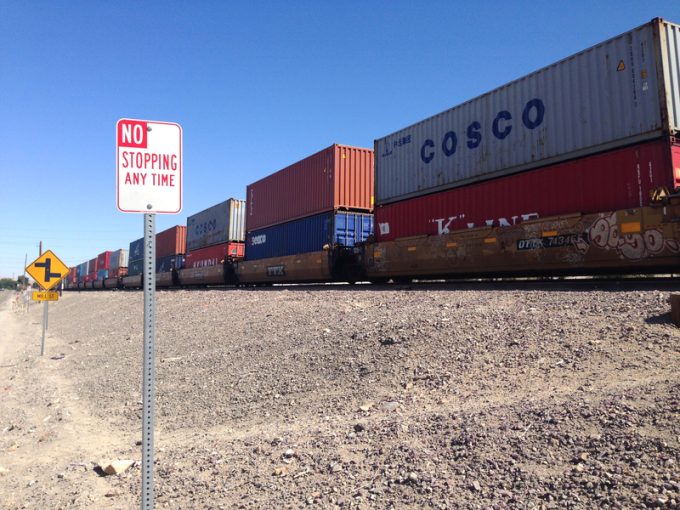‘Inflection’ nowhere in sight as mixed US freight market seeks direction
Health check: bottom, what bottom?
FDX: ABOUT USPS PRIVATISATIONFDX: CCO VIEWFDX: LOWER GUIDANCE FDX: DISRUPTING AIR FREIGHTFDX: FOCUS ON KEY VERTICALFDX: LTL OUTLOOKGXO: NEW LOW LINE: NEW LOW FDX: INDUSTRIAL WOESFDX: HEALTH CHECKFDX: TRADING UPDATEWMT: GREEN WOESFDX: FREIGHT BREAK-UPFDX: WAITING FOR THE SPINHON: BREAK-UP ALLUREDSV: BREACHING SUPPORTVW: BOLT-ON DEALAMZN: TOP PICK
FDX: ABOUT USPS PRIVATISATIONFDX: CCO VIEWFDX: LOWER GUIDANCE FDX: DISRUPTING AIR FREIGHTFDX: FOCUS ON KEY VERTICALFDX: LTL OUTLOOKGXO: NEW LOW LINE: NEW LOW FDX: INDUSTRIAL WOESFDX: HEALTH CHECKFDX: TRADING UPDATEWMT: GREEN WOESFDX: FREIGHT BREAK-UPFDX: WAITING FOR THE SPINHON: BREAK-UP ALLUREDSV: BREACHING SUPPORTVW: BOLT-ON DEALAMZN: TOP PICK

In July the US Surface Transportation Board (STB) took the unusual step of summoning the Class I rail carriers to a hearing to examine strategies to regain dwindling business. However, preliminary input from shippers indicates that this quest is going to be an uphill battle.
Robert Primus, who took over as STB chairman in May, appears to be bent on pursuing the path of his predecessor, who repeatedly lambasted the railways on their service record and questioned their commitment to improvement. On 16 and 17 September the regulator is going to hold a hearing in Washington, where the heads of the six large Class I railways are to explain their strategies for growth and their investment plans.
The STB wants to hear about short-, mid- and long-term strategies of the railways to grow their business and their investment plans by types of traffic targeted. In the summons to the hearing it expressed concern about rail transport losing ground to trucking.
“While the board recognises that some shifts in volume may not be primarily within the control of rail carriers, the board has observed that over the past 10 years carload volumes have not grown, and have in fact decreased,” it wrote, pointing to a report by the Federal Reserve of St Louis, according to which carload traffic shrank 28% between May 2014 and May of this year.
“The board wishes to explore how industry participants are strategising and innovating to reverse this recent trend and achieve freight rail growth,” it stated.
Over the past couple of years the STB has held hearings on deteriorating rail reliability, questioning the carriers’ commitment to service improvement. Its remit also tasks the agency to ensure the railways are healthy and earning adequate revenues. Its notice issued at the end of last month shows that three US class I carriers were ‘revenue adequate’ in 2023, down from five carriers the year before.
A rail carrier is considered revenue adequate if it achieves a rate of return on net investment equal to at least the current cost of capital to the industry, which currently stands at 9.87%.
In addition to the Class I carrier heads, the STB has invited shippers, suppliers and labour representatives to testify at the meeting. Early submissions from cargo owners and their organisations criticise rail carrier reliability, with one shipper stating that deteriorating rail performance makes it hard to retain customers. Others have corroborated this, stating that they would chose trucking instead because of that sector’s higher reliability, notwithstanding its inferior safety record.
Beyond the sheer reliability issue, there is doubt over whether railways actually want to grow their business. One shipper argued that the carriers follow the dictates of Wall Street, which is looking for reduced expenses to drive up profitability more than anything else, rather than ask for increased business.
This ties into the debate about precision scheduled railroading (PSR), which has been blamed by previous STB chairman Martin Oberman and a number of shippers and observers for deteriorating service. The Private Railcar Food and Beverage Association argued in its comments that PSR has prompted rail carriers to reduce traffic lanes, effectively taking capacity out of the market.
The Freight Rail Customer Alliance has expressed hope that the hearing will focus on the extent to which the carriers’ pursuit of lower operating ratios [the central tenet of PSR] has caused them to turn down profitable traffic. It accuses the railways of having often been unable or unwilling to handle available volume.
In its comments the Association of American Railroads (AAR) has refuted these accusations, claiming that all of its members would love to take on more traffic. Faltering consumer demand could stymie rail growth in the near future, it stated.
In addition, government policy may limit its members ability to grow, the AAR claimed. It pointed to BNSF’s planned $1.5bn intermodal facility in Bartow, which would not be viable under the California Air Resource Board’s proposed requirement that locomotives produced after 2035 operating in California would have to be zero-emission models, as this would effectively ban the deployment of locomotives that are over 23 years old, according to BNSF.
Check out this clip from The Loadstar Podcast on how Asia-Europe rail demand is soaring
Comment on this article